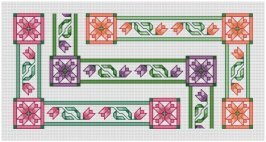Needle Threaders for Cross Stitch
Threading needles with floss bears little resemblance to threading sewing thread. One strand may be manageable. But every strand you add beyond that just increases your frustration level. The floss threads separate in every way possible. There is a quick, easy and inexpensive solution. So . . .
|
Even if you've never used a needle threader . . . even if you have perfect eyesight, even if you only cross stitch in excellent light, even if you use a magnification device, even if you can thread a needle with your eyes closed . . . do yourself (and everyone around you) a favor and buy at least one needle threader!. |
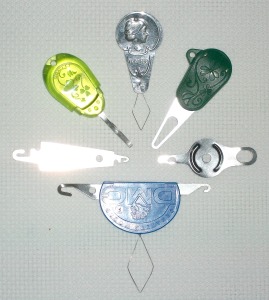 Needle Threaders for Cross Stitch Needle Threaders for Cross Stitch |
The Best Needle Threader Choices
When I first started this website, most needle threaders were a variation of an already bad choice. You know the one I'm talking about. That thin little wire one that breaks if you look at it the wrong way. I found there was only one usable, reliable needle threader to use with the #26 and #24 tapestry needles that I use for cross stitching.
It's great to find a product that works, dependably, every time you use it. No more spending money on items that it don't live up to their advertising. The unfortunate result is that you often stop looking at new products.
But when I stocked my Amazon store, better-cross-stitch-supplies, I discovered several new needle threaders that warranted my, and your, attention.
I ordered the most promising candidates for use specifically with floss and three sizes of tapestry needles. Because of my findings, I now have a NEW favorite needle threader. Here's what I discovered:
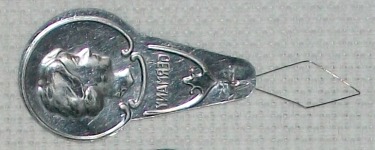
from multiple vendors
- This is an example of the type of threader to avoid.
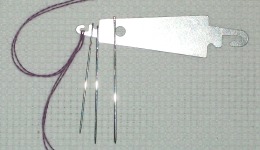
from LoRan (using smallest hook)
- Fits needle sizes #24, #26, #28
- Pros: easy to thread into the needle eye; has a notch for resting the needle while looping floss over hook; easy to use
- Cons: metal sometimes has rough edges that scrape the eye of the needle; if you don't keep it straight, the hook can get hung up on the needle eye when pulling the threader back through with the floss; location of hole causes tether to get in the way during use
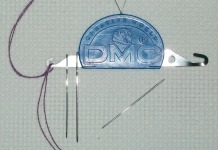
from DMC & Janlynn (using smallest hook)
- Fits needle sizes #24 easily; #26 tightly; doesn't fit #28
- Pros: easy to use; hole for tether conveniently located (if you don't need access to larger hook)
- Cons: doesn't fit all three needle sizes; if you don't keep it straight, the hook can get hung up on the needle eye when pulling the threader back through with the floss
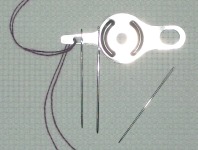
from Dritz (using the smallest end)
- Fits needle size #24 easily, #26 with difficulty, doesn't fit #28
- Pros: easy to thread into the needle eye; comes in 2-pack
- Cons: doesn't fit all three needle sizes; rough edges around the metal hole scrapes the eye of the needle; has a smaller eye for threading compared with others; location of hole causes tether to get in the way during use
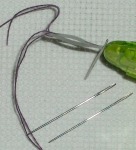
from Clover
- Fits all three needle sizes #24, #26, #28 easily
- Pros: smooth metal edges for easy threading into the needle eye; easy to use;
conveniently located hole for attaching a tether; a clear cover slides on to protect metal threader end
- Cons: easy to bend the thin flattened metal end
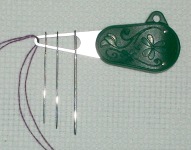
from Clover
- Fits all three needle sizes #24, #26, #28 easily
- Pros: smooth metal edges for easy threading into the needle eye; large opening for floss threading even with smallest needle; easy to use; conveniently located hole for attaching a tether
- Cons: the manufacturer calls this a "yarn" threader, so cross stitchers may overlook this one
You may have noticed that some of these needle threaders, made with flattened metal, can have rough edges. It isn't always one brand versus another. I purchased one that was perfectly smooth, then a second one--the exact brand and style--that was rough. If that happens, try this:
- lay the metal threader flat on a cloth-covered, hard surface
- lay the emery board flatly on the surface of the threader
- rub back and forth on both sides until the rough metal is sanded smooth
Don't file the edges like your fingernails; you are buffing the surface smooth. Be sure to use the padded emery boards (they frequently come in pink or charcoal), not the hard cardboard type. You can find them at your local discount or drug store. This easy fix transforms an unusable threader into a workable device.
And the runners up are . . .
|
Thanks for checking out these great products from Amazon! The commission I earn, at no cost to you, helps me bring this website to you free of charge. --Katherine |
My NEW Favorite Needle Threader!
|
Whichever needle threader you choose - a word of caution. Different brands and styles have different "hook" or "threader" sizes. Even if it appears to be the same, make sure that the one you purchase fits easily through the eyes of the needles you'll be using. What about "mechanical" or "automatic" needle threaders?While I've had some success using them with standard sewing thread, embroidery floss just doesn't behave the same. For me, they were inconvenient, awkward, unpredictable and ultimately, just too much trouble. If you are inclined to try one of these devices, let us know how you like them! |
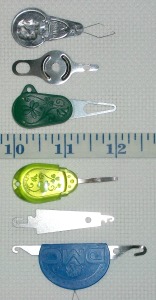 Needle Threader Sizes Needle Threader Sizes |
"Oh no! I forgot to bring my threader!"
It happens to all of us, but here's a way to thread your needle without straining your eyes and your nerves. It uses a small slip of paper to get the floss through the needle.
Away from home? Snip off the corner of a grocery receipt, deposit slip, magazine or envelope. (How's that for needle accessories!) The paper will be folded, so it can't be too thick.
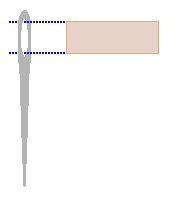 Step 1. Cut a slip of paper narrower than the eye of the needle.
Step 1. Cut a slip of paper narrower than the eye of the needle.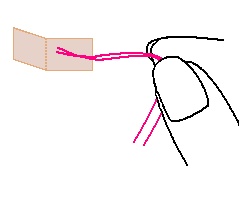 Step 2. Place the floss ends on one half of the paper.
Step 2. Place the floss ends on one half of the paper.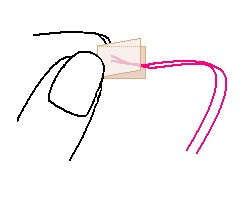 Step 3. Fold the paper over the floss. Crease the paper.
Step 3. Fold the paper over the floss. Crease the paper.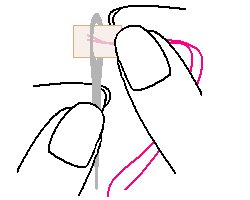 Step 4. Thread the paper (floss inside) through the needle eye.
Step 4. Thread the paper (floss inside) through the needle eye.Now, I know this little slip of paper isn't very durable. You won't be adding it to the needle accessories in your stitching bag, but it will do in a pinch. When it wears out, clip another one!
Thimbles: the other needle accessory
Another needle accessory that you might consider is a thimble. Most of us hold the cross stitch needle between the thumb and forefinger of
our dominant hand, using the middle finger to push the needle through
the cloth. A thimble protects the end of that finger from getting sore.
The nature of counted cross stitch most often calls for your needle to slide easily into a premade or obvious opening, making the thimble optional. Anything on my fingers feels a bit awkward, so I prefer to have my normal dexterity, unhidindered by a tool that I rarely need.
That said, I have known people that always use thimbles. Ultimately, the right choice for you . . . is the right choice. Today, thimbles can be made of metal, leather, leather with metal insets, even some type of heat resistant thermal material!
|
They can also be made of plastic in sizes ranging from 6 (smallest) to 12 (largest). It should fit snugly enough to keep from falling off but loose enough not to pinch. Some stitchers use another finger, so get whatever size fits the finger you use most. If you're unsure about the size, ask a clerk to open a package so you can try them on. If I were to try something new, I'd check out these thimble pads. They look far less obtrusive than a typical, cover-the-end-of-your-finger type. You can see a variety of thimbles on Amazon. As always, check reviews before buying. They go a long way in uncovering products that may have undesirable characteristics, when using them for cross stitching. |
Return to top of Needle Threaders for Cross Stitch
Return from Needle Threaders for Cross Stitch to Counted Cross Stitch Supplies
Go to Better Cross Stitch Patterns Home Page



